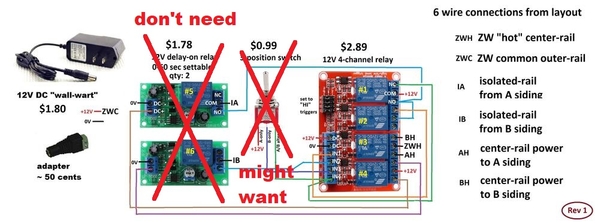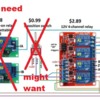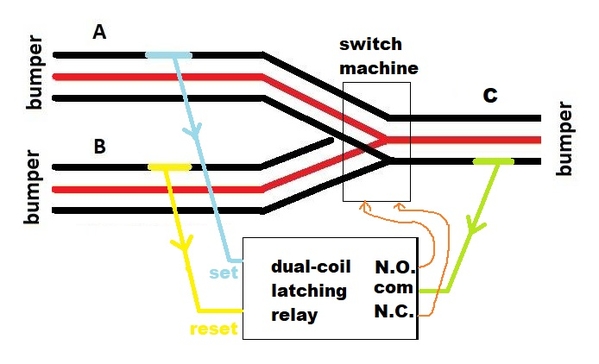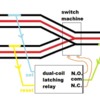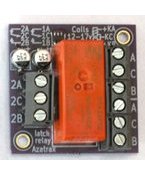Logic dictates that the switch should be thrown when the trolley hits the common bumper (C in Big Boy 4005). That way the trolley would go to leg A and come back to hit the bumper at C. That would throw the switch so the trolley will then go B and so on. How to get the bumper powered to the switch is the question.
One component which may come into play for this specific application is a dual-coil latching relay. That is, when the trolley enters the A path, the insulated rail triggers the "set" coil. When the trolley enters the B path, the insulated rail triggers the "reset" coil. The output of this relay is then used to select which switch machine is fired when the trolley is in the C path.
While latching relays are only a couple bucks they require soldering and such; when mounted on a module with screw-terminals the off-the-shelf versions are $10 or more. One technique is to take advantage of the insanely low priced eBay relay modules and wire these non-latching relays into a latching configuration. I show this in this OGR thread with a related though not the same application.
Here's a pic from that thread. I believe you can do your specific application with the components shown below. No soldering required! One idea is to include a bypass switch to force the trolley to ONLY use the A or B path...rather than alternating A or B.
Attachments
stan2004 posted:One component which may come into play for this specific application is a dual-coil latching relay. That is, when the trolley enters the A path, the insulated rail triggers the "set" coil. When the trolley enters the B path, the insulated rail triggers the "reset" coil. The output of this relay is then used to select which switch machine is fired when the trolley is in the C path.
While latching relays are only a couple bucks they require soldering and such; when mounted on a module with screw-terminals the off-the-shelf versions are $10 or more. One technique is to take advantage of the insanely low priced eBay relay modules and wire these non-latching relays into a latching configuration. I show this in this OGR thread with a related though not the same application.
Here's a pic from that thread. I believe you can do your specific application with the components shown below. No soldering required! One idea is to include a bypass switch to force the trolley to ONLY use the A or B path...rather than alternating A or B.
Exactly! Thanks Stan, I was even thinking of that specific relay module and power supply for this.
Gentlemen, we have this same electrical requirement in modern pipe organ consoles where each stop key or knob has on and off solenoids built into it. A push button t will move the stop to the other position from what it currently is. Even if you manually move the stop, the logic senses what to do next time you press the button. The circuit boards (called “Reversibles”) (12v DC) are available. Check with your local pipe organ installer or service technician for sources.
Big_Boy_4005 posted:stan2004 posted:One component which may come into play for this specific application is a dual-coil latching relay. That is, when the trolley enters the A path, the insulated rail triggers the "set" coil. When the trolley enters the B path, the insulated rail triggers the "reset" coil. The output of this relay is then used to select which switch machine is fired when the trolley is in the C path.
While latching relays are only a couple bucks they require soldering and such; when mounted on a module with screw-terminals the off-the-shelf versions are $10 or more. One technique is to take advantage of the insanely low priced eBay relay modules and wire these non-latching relays into a latching configuration. I show this in this OGR thread with a related though not the same application.
Here's a pic from that thread. I believe you can do your specific application with the components shown below. No soldering required! One idea is to include a bypass switch to force the trolley to ONLY use the A or B path...rather than alternating A or B.
Exactly! Thanks Stan, I was even thinking of that specific relay module and power supply for this.
I am sorry but I am a little confused. How does that relay alternate between A and B? Every time the trolley lands in C triggers the relay, I don't understand how to make it bounce between the two routes. If you can explain I would be grateful.
The trick is the "memory" function of a latching relay. That is, you only need to momentarily trigger the relay to change its position and it remembers the new position even after removing the trigger (voltage). In general a latching relay has a "set" input and a "reset" input. In this example, when the trolley runs over the A insulated section, it sets the relay. When the trolley runs over the B insulated section, it resets the relay. When the trolley runs over the C insulated section, it applies power to the switch machine to toggle the direction. That is, if the trolley last hit the A section, the relay will be set to apply the C trigger to change the switch to the B position. If the trolley last hit the B section, the relay will be reset to apply the C trigger to change the switch to the A position. That is how it alternates.
What's subtle is what Elliot described in one of his posts. The latching relay is toggled when the trolley enters the A or B section. You cannot have the relay toggle from the C section. Why? Because you can get multiple triggers from dirty track!
Attachments
Wow!!! Stan2004, I don't know how to thank you. Have a couple of questions:
Do I leave the insulating pins in the switch?
What gauge wire would be best to use?
Stan, thanks for getting me off the the hook with that diagram. My brain was starting to hurt, and I was losing sleep. I knew it could be done. That latching relay really makes it look simple. Well worth a few extra bucks to do it that way. I had all the pieces of the puzzle.![]()
Richard, yes, leave the insulating pins in the switch. Taking them out would cause the points to lock in one way or vibrate back and forth. Both bad. The switch in this application won't use the anti-derailing feature. The relay is doing the throwing, but they still need to be there.
Z stuff has a display layout seen a York that exhibits this feature. I believe a 1008 relay and 2500 switch machine were part of the solution.
Richard Landreth posted:
...What gauge wire would be best to use?
Whatever wire gauge came with the switch and controller would work fine - probably AWG 24 or so. Note that the "large" current only flows momentarily when the switch flips position.
But so I'm clear, which implementation are you thinking of? You can buy a latching relay module off-the-shelf from, say, Azatrax for about $14 plus $8 shipping:
It has screw-terminals so you don't have to mess with soldering. And their AC version directly handles AC coil voltage so you don't have to mess with DC. But if, for example, the 10-15V operating voltage of the Azatrax latching relay is not suitable for however fast/slow you run your trolleys, then perhaps more assistance is in order. If you're on top of all this, then you're on your way and I await to hear how it works out!
OTOH I'm the consummate cheap-skate and have been known to amuse myself fiddling with low-cost eBay free-shipping-from-Asia gadgets where you can get it done for closer to $5 though you have to mess around with more wiring.
Attachments
I am going with the latching relay system. When all the parts arrive and I get it installed (or hit a snag), I will let you know how things go. Thanks for all your help and time.
I don't think control and turnout type were mentioned, I didn't read close after because I knew Elliot was right. But depending on equipment, an old 2 position e-unit and switch "at C" would do it old school style.
For reliability, I'd skip isolated rail triggers, the low wheel count and light weight of bump and go makes it sketchy. If the bumper option doesn't pan out (plenty of pressure; it already throws one switch... but mounting...? The PW lighted bumpers light would always blink when hit, but I'm not sure if that was by design or pressure disconnect from track.. If by design, a relay on n.open,to add power to the e-unit for a flash would work.
Otherwise a micro switch with a wire wisker throw arm would likely be my choice. Whatever method, note the switch must be at the far end of C so it cannot be thrown twice, once before and after the "bounce". However, mid run triggering between turnout and C could be done with a 3 position E-unit.
The e-unit itself is a mechanical latching vs electrical latching relay ![]()
Guitarmike posted:Big_Boy_4005 posted:stan2004 posted:One component which may come into play for this specific application is a dual-coil latching relay. That is, when the trolley enters the A path, the insulated rail triggers the "set" coil. When the trolley enters the B path, the insulated rail triggers the "reset" coil. The output of this relay is then used to select which switch machine is fired when the trolley is in the C path.
While latching relays are only a couple bucks they require soldering and such; when mounted on a module with screw-terminals the off-the-shelf versions are $10 or more. One technique is to take advantage of the insanely low priced eBay relay modules and wire these non-latching relays into a latching configuration. I show this in this OGR thread with a related though not the same application.
Here's a pic from that thread. I believe you can do your specific application with the components shown below. No soldering required! One idea is to include a bypass switch to force the trolley to ONLY use the A or B path...rather than alternating A or B.
Exactly! Thanks Stan, I was even thinking of that specific relay module and power supply for this.
I am sorry but I am a little confused. How does that relay alternate between A and B? Every time the trolley lands in C triggers the relay, I don't understand how to make it bounce between the two routes. If you can explain I would be grateful.
Mike, using that relay module, you could create your own latching relay by wiring them together in the correct way. That was where my rust was showing, and why my brain was hurting. I've done that before with standard relays, but I'm sure Stan has more practice and experience, and could draw it up in a couple minutes.
All the relay does, is keep track of which leg, A or B, you visited last. By doing that, when you get to C, you throw the switch the other way. The trigger at C is the insulated section, which routes that ground signal through the relay contacts to throw the switch the correct way. It is a very elegant solution!
Wouldn't this be the same as using a single-throw double-pole (STDP) momentary-on push-button switch that could be mounted in the bumper? The momentary-on is required to prevent burning out the coils of the switch machine unless you are using a switch motor that denergizes the coils when it moves.
Jan
Jan posted:Wouldn't this be the same as using a single-throw double-pole (STDP) momentary-on push-button switch that could be mounted in the bumper? The momentary-on is required to prevent burning out the coils of the switch machine unless you are using a switch motor that denergizes the coils when it moves.
Depends on what you mean by "this". As I see it, the key component/function is the latching relay...or something equivalent that remembers which direction the switch should flip to next.
But if you're referring to previous comments about the reliability of the insulated-rail method with lightweight trolleys, then sure, you could use momentary push-buttons mounted in each of the bumpers (A, B, and C). The A and B push-buttons (or hand-built spring lever contacts) would momentarily trigger the set and reset coil inputs of the latching relay. The C push-button would momentarily supply power to the "COM" output of the latching relay which steers that power to one of the two turnout solenoid mechanisms.
Stan2004, after looking more closely at the schematic, I started to get confused. Sorry for being such a dummy, but electrical things are not my forte.
Quetions:
1. I see 3 12V lines coming from the delay module, but where do they end up and what are they since the delay module is not being used?
2. Where is the the ZWC connect? I see it in the description but not on the relay
3. A green wire is shown coming from the delay module and jumpering between A1 and A2 on the relay.How is it wired now that the delay module is not being used?
Where is the B1 wired and where does it go?
Are you intending to use the off-the-shelf latching relay module from Azatrax (or the like)… or cobble together the latching function using a multi-relay non-latching eBay relay module as shown in my diagram? I may have misunderstood you previous response but I thought you were going with the Azatrax method.
The diagram I showed with ZWC and so on was just a cut-and-paste from the other thread with a similar but not quite the same trolley configuration. That version required delay modules and so on. Your application is simpler and does not require delay modules. I can draw up a diagram for your specific trolley application. So,
1. Which latching relay method are you planning to use?
2. What is your power source/transformer?
I am going to using a HiLetgo 12V 4 channel relay module I got from Amazon (https://www.amazon.com/gp/prod...00?ie=UTF8&psc=1). My transformer is a Lionel ZW 275w. You are really great to be doing this. I can't thank you enough.
stan2004 posted:Are you intending to use the off-the-shelf latching relay module from Azatrax (or the like)… or cobble together the latching function using a multi-relay non-latching eBay relay module as shown in my diagram? I may have misunderstood you previous response but I thought you were going with the Azatrax method.
The diagram I showed with ZWC and so on was just a cut-and-paste from the other thread with a similar but not quite the same trolley configuration. That version required delay modules and so on. Your application is simpler and does not require delay modules. I can draw up a diagram for your specific trolley application. So,
1. Which latching relay method are you planning to use?
2. What is your power source/transformer?
Stan, are you Stan Roy who was featured in the McComas and Tuoy 6 video set, and who had the record for simultaneously running the most O Gauge trains (maybe 27)?
I can't help but think that you are because of your knowledge about relays. Arnold
Arnold D. Cribari posted:Stan, are you Stan Roy who was featured in the McComas and Tuoy 6 video set, and who had the record for simultaneously running the most O Gauge trains (maybe 27)?
I can't help but think that you are because of your knowledge about relays. Arnold
An interesting question Arnold. You must then know that I once tried to challenge that record, if you remember volume 6. If you don't, watch it again.![]()





